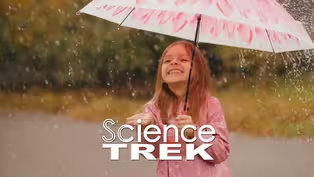
Weather: Blobs That Crash
Clip: Special | 1m 4sVideo has Closed Captions
How do blobs of air create storms?
Blobs of air move around the atmosphere. Where two blobs meet, they create a front. Those fronts cause some of our strongest weather.
Problems playing video? | Closed Captioning Feedback
Problems playing video? | Closed Captioning Feedback
Science Trek is a local public television program presented by IdahoPTV
Major Funding by the Laura Moore Cunningham Foundation and the Idaho National Laboratory. Additional Funding by the Friends of Idaho Public Television and the Corporation for Public Broadcasting.

Weather: Blobs That Crash
Clip: Special | 1m 4sVideo has Closed Captions
Blobs of air move around the atmosphere. Where two blobs meet, they create a front. Those fronts cause some of our strongest weather.
Problems playing video? | Closed Captioning Feedback
How to Watch Science Trek
Science Trek is available to stream on pbs.org and the free PBS App, available on iPhone, Apple TV, Android TV, Android smartphones, Amazon Fire TV, Amazon Fire Tablet, Roku, Samsung Smart TV, and Vizio.

Science Trek
Science Trek is a place where parents, kids, and educators can watch short, educational videos on a variety of science topics. Every Monday Science Trek releases a new video that introduces children to math, science, technology, engineering, and math (STEM) career potentials in a fun, informative way.[MUSIC] Joan Cartan-Hansen, Host: Because the sun heats the Earth unevenly, we get what are called air masses.
An air mass is a blob of air that has the same temperature and amount of moisture or humidity in it.
Air masses don't mix.
These blobs push, and shove and crash into each other.
The line where two air masses meet is called a front.
Fronts change the weather by creating clouds, rains, winds and storms.
A cold front happens where the edge of cold air moves into a warm air mass.
Cold air weighs more and pushes the lighter warm air up.
The rising warm air cools, creating clouds and storms.
A warm front is the line between where a warm air mass slides over a heavier cold air.
The rising warm air creates thick clouds.
A stationary front happens when neither the cold air blob or the warm air blob can move.
If the air is humid, you can get a lot of cloudy skies and drizzling rain for days.
For more information about the weather, check out the science trek website.
You'll find it at science trek dot org
Video has Closed Captions
Clip: Special | 1m 4s | What is air pressure? (1m 4s)
Providing Support for PBS.org
Learn Moreabout PBS online sponsorship
- Science and Nature

Explore scientific discoveries on television's most acclaimed science documentary series.

- Science and Nature

Capturing the splendor of the natural world, from the African plains to the Antarctic ice.
Winnipeg In Bloom











Support for PBS provided by:
Science Trek is a local public television program presented by IdahoPTV
Major Funding by the Laura Moore Cunningham Foundation and the Idaho National Laboratory. Additional Funding by the Friends of Idaho Public Television and the Corporation for Public Broadcasting.
